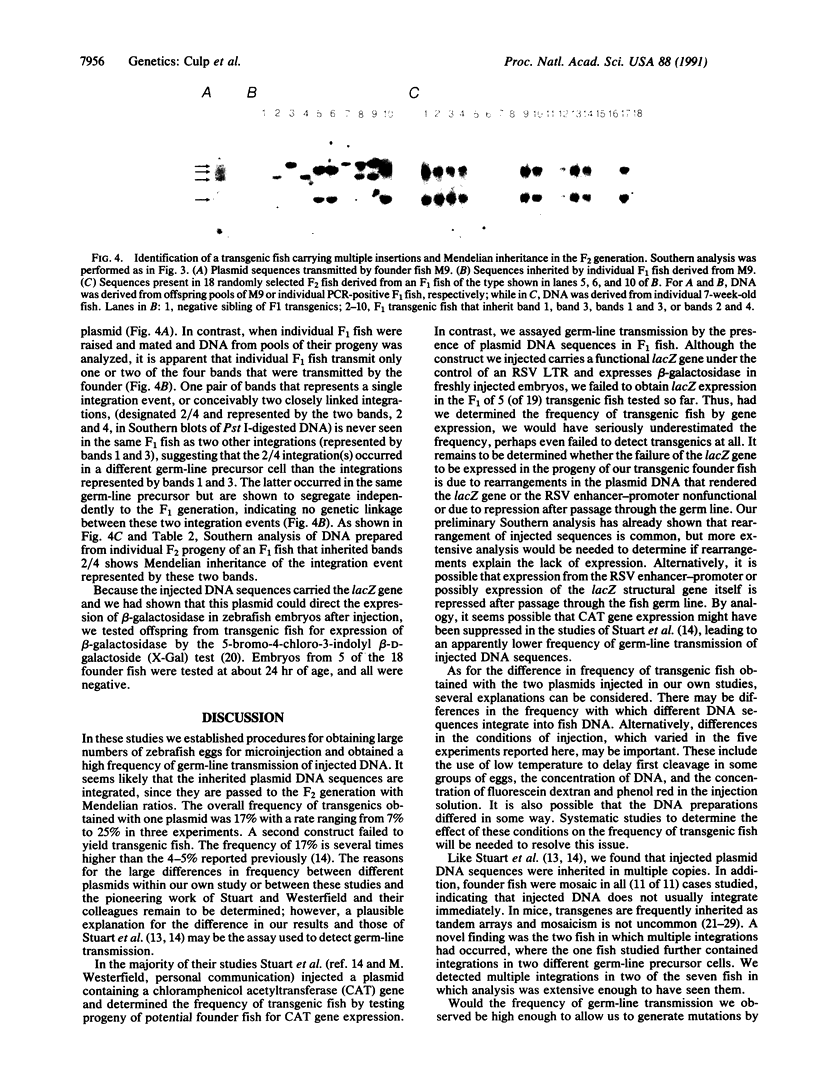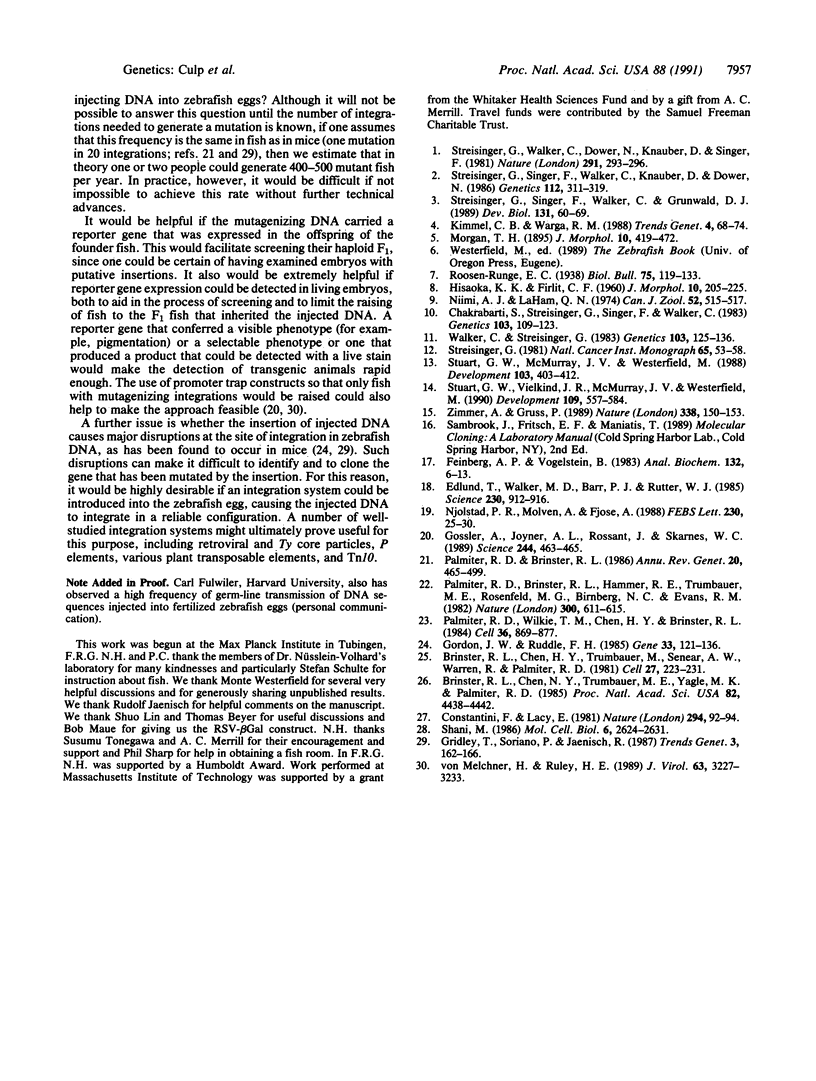Abstract
With the goal of developing techniques for DNA insertional mutagenesis in zebrafish, we established procedures for rapidly obtaining and injecting large numbers of fertilized eggs. Using either of two plasmid constructs, we injected uncut DNA into fertilized eggs at the one- or two-cell stage. Fish hatched from injected eggs were raised to sexual maturity, and the frequency of transgenic founder fish was determined by pair-mating the fish and testing DNA extracted from pools of their 16-hr-old offspring by the polymerase chain reaction (PCR) and then Southern analysis. Eggs injected with one of two different plasmids yielded no transgenic fish, but 7-25% (19 of 115 overall) of the eggs injected with the other plasmid transmitted the injected sequences to their offspring (F1). Of seven lines studied further, all were able to pass the foreign DNA sequences to the next (F2) generation. Inheritance in the F2 generation was Mendelian in the five lines tested. PCR and Southern analysis indicated that the plasmid sequences were present in multiple copies, probably tandemly arranged. Two founder fish carried more than one independent integration of the plasmid sequences. The line studied in more detail was a mosaic carrying two independently segregating copies of the transgene in one germ cell and a third copy in another germ-line precursor cell. The ability to obtain and inject large numbers of zebrafish eggs combined with a high frequency of germ-line integration may be steps toward the goal of being able to perform insertional mutagenesis with this organism.
Full text
PDF




Images in this article
Selected References
These references are in PubMed. This may not be the complete list of references from this article.
- Brinster R. L., Chen H. Y., Trumbauer M. E., Yagle M. K., Palmiter R. D. Factors affecting the efficiency of introducing foreign DNA into mice by microinjecting eggs. Proc Natl Acad Sci U S A. 1985 Jul;82(13):4438–4442. doi: 10.1073/pnas.82.13.4438. [DOI] [PMC free article] [PubMed] [Google Scholar]
- Brinster R. L., Chen H. Y., Trumbauer M., Senear A. W., Warren R., Palmiter R. D. Somatic expression of herpes thymidine kinase in mice following injection of a fusion gene into eggs. Cell. 1981 Nov;27(1 Pt 2):223–231. doi: 10.1016/0092-8674(81)90376-7. [DOI] [PMC free article] [PubMed] [Google Scholar]
- Chakrabarti S., Streisinger G., Singer F., Walker C. Frequency of gamma-Ray Induced Specific Locus and Recessive Lethal Mutations in Mature Germ Cells of the Zebrafish, BRACHYDANIO RERIO. Genetics. 1983 Jan;103(1):109–123. doi: 10.1093/genetics/103.1.109. [DOI] [PMC free article] [PubMed] [Google Scholar]
- Costantini F., Lacy E. Introduction of a rabbit beta-globin gene into the mouse germ line. Nature. 1981 Nov 5;294(5836):92–94. doi: 10.1038/294092a0. [DOI] [PubMed] [Google Scholar]
- Edlund T., Walker M. D., Barr P. J., Rutter W. J. Cell-specific expression of the rat insulin gene: evidence for role of two distinct 5' flanking elements. Science. 1985 Nov 22;230(4728):912–916. doi: 10.1126/science.3904002. [DOI] [PubMed] [Google Scholar]
- Feinberg A. P., Vogelstein B. A technique for radiolabeling DNA restriction endonuclease fragments to high specific activity. Anal Biochem. 1983 Jul 1;132(1):6–13. doi: 10.1016/0003-2697(83)90418-9. [DOI] [PubMed] [Google Scholar]
- Gordon J. W., Ruddle F. H. DNA-mediated genetic transformation of mouse embryos and bone marrow--a review. Gene. 1985;33(2):121–136. doi: 10.1016/0378-1119(85)90087-3. [DOI] [PubMed] [Google Scholar]
- Gossler A., Joyner A. L., Rossant J., Skarnes W. C. Mouse embryonic stem cells and reporter constructs to detect developmentally regulated genes. Science. 1989 Apr 28;244(4903):463–465. doi: 10.1126/science.2497519. [DOI] [PubMed] [Google Scholar]
- Kimmel C. B., Warga R. M. Cell lineage and developmental potential of cells in the zebrafish embryo. Trends Genet. 1988 Mar;4(3):68–74. doi: 10.1016/0168-9525(88)90043-1. [DOI] [PubMed] [Google Scholar]
- Niimi A. J., LaHam Q. N. Influence of breeding time interval on egg number, mortality, and hatching of the zebra fish Brachydanio verio. Can J Zool. 1974 Apr;52(4):515–517. doi: 10.1139/z74-063. [DOI] [PubMed] [Google Scholar]
- Njølstad P. R., Molven A., Fjose A. A zebrafish homologue of the murine Hox-2.1 gene. FEBS Lett. 1988 Mar 28;230(1-2):25–30. doi: 10.1016/0014-5793(88)80634-3. [DOI] [PubMed] [Google Scholar]
- Palmiter R. D., Brinster R. L. Germ-line transformation of mice. Annu Rev Genet. 1986;20:465–499. doi: 10.1146/annurev.ge.20.120186.002341. [DOI] [PMC free article] [PubMed] [Google Scholar]
- Palmiter R. D., Brinster R. L., Hammer R. E., Trumbauer M. E., Rosenfeld M. G., Birnberg N. C., Evans R. M. Dramatic growth of mice that develop from eggs microinjected with metallothionein-growth hormone fusion genes. Nature. 1982 Dec 16;300(5893):611–615. doi: 10.1038/300611a0. [DOI] [PMC free article] [PubMed] [Google Scholar]
- Palmiter R. D., Wilkie T. M., Chen H. Y., Brinster R. L. Transmission distortion and mosaicism in an unusual transgenic mouse pedigree. Cell. 1984 Apr;36(4):869–877. doi: 10.1016/0092-8674(84)90036-9. [DOI] [PubMed] [Google Scholar]
- Shani M. Tissue-specific and developmentally regulated expression of a chimeric actin-globin gene in transgenic mice. Mol Cell Biol. 1986 Jul;6(7):2624–2631. doi: 10.1128/mcb.6.7.2624. [DOI] [PMC free article] [PubMed] [Google Scholar]
- Streisinger G. Attainment of minimal biological variability and measurements of genotoxicity: production of homozygous diploid zebra fish. Natl Cancer Inst Monogr. 1984 May;65:53–58. [PubMed] [Google Scholar]
- Streisinger G., Coale F., Taggart C., Walker C., Grunwald D. J. Clonal origins of cells in the pigmented retina of the zebrafish eye. Dev Biol. 1989 Jan;131(1):60–69. doi: 10.1016/s0012-1606(89)80038-7. [DOI] [PubMed] [Google Scholar]
- Streisinger G., Singer F., Walker C., Knauber D., Dower N. Segregation analyses and gene-centromere distances in zebrafish. Genetics. 1986 Feb;112(2):311–319. doi: 10.1093/genetics/112.2.311. [DOI] [PMC free article] [PubMed] [Google Scholar]
- Streisinger G., Walker C., Dower N., Knauber D., Singer F. Production of clones of homozygous diploid zebra fish (Brachydanio rerio). Nature. 1981 May 28;291(5813):293–296. doi: 10.1038/291293a0. [DOI] [PubMed] [Google Scholar]
- Stuart G. W., McMurray J. V., Westerfield M. Replication, integration and stable germ-line transmission of foreign sequences injected into early zebrafish embryos. Development. 1988 Jun;103(2):403–412. doi: 10.1242/dev.103.2.403. [DOI] [PubMed] [Google Scholar]
- Stuart G. W., Vielkind J. R., McMurray J. V., Westerfield M. Stable lines of transgenic zebrafish exhibit reproducible patterns of transgene expression. Development. 1990 Jul;109(3):577–584. doi: 10.1242/dev.109.3.577. [DOI] [PubMed] [Google Scholar]
- Walker C., Streisinger G. Induction of Mutations by gamma-Rays in Pregonial Germ Cells of Zebrafish Embryos. Genetics. 1983 Jan;103(1):125–136. doi: 10.1093/genetics/103.1.125. [DOI] [PMC free article] [PubMed] [Google Scholar]
- Zimmer A., Gruss P. Production of chimaeric mice containing embryonic stem (ES) cells carrying a homoeobox Hox 1.1 allele mutated by homologous recombination. Nature. 1989 Mar 9;338(6211):150–153. doi: 10.1038/338150a0. [DOI] [PubMed] [Google Scholar]
- von Melchner H., Ruley H. E. Identification of cellular promoters by using a retrovirus promoter trap. J Virol. 1989 Aug;63(8):3227–3233. doi: 10.1128/jvi.63.8.3227-3233.1989. [DOI] [PMC free article] [PubMed] [Google Scholar]





